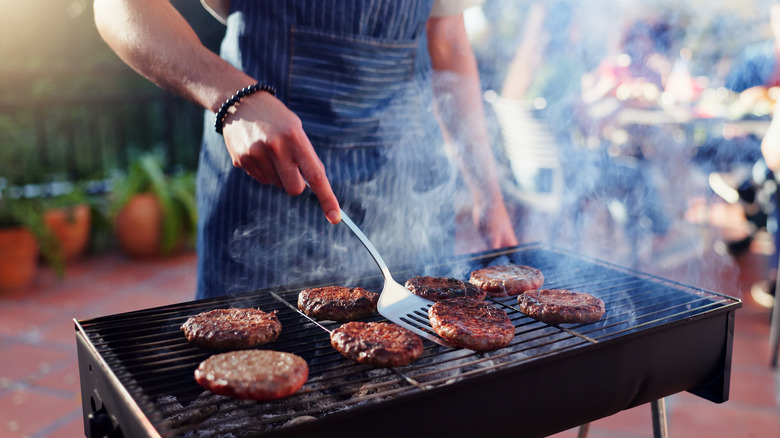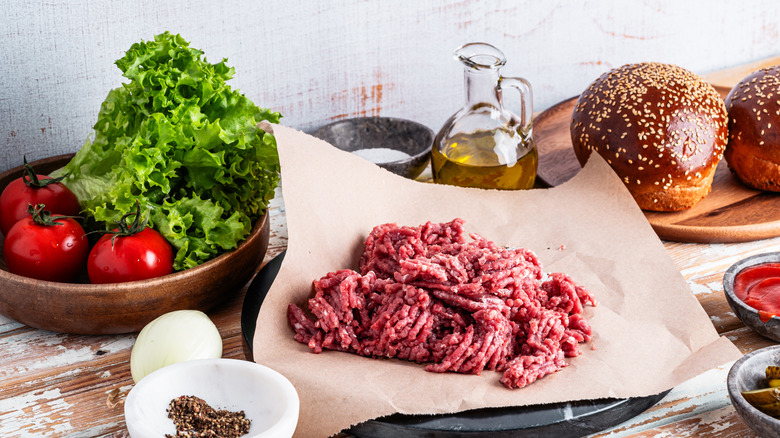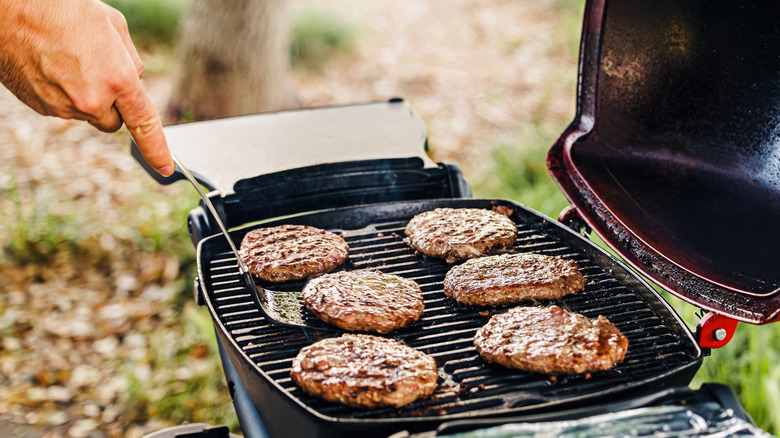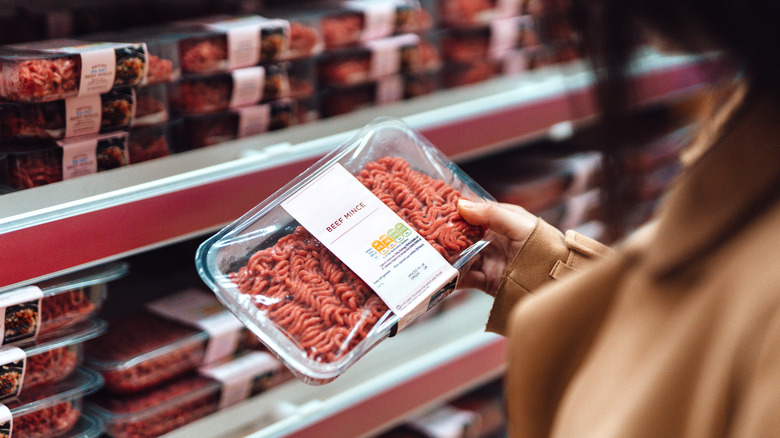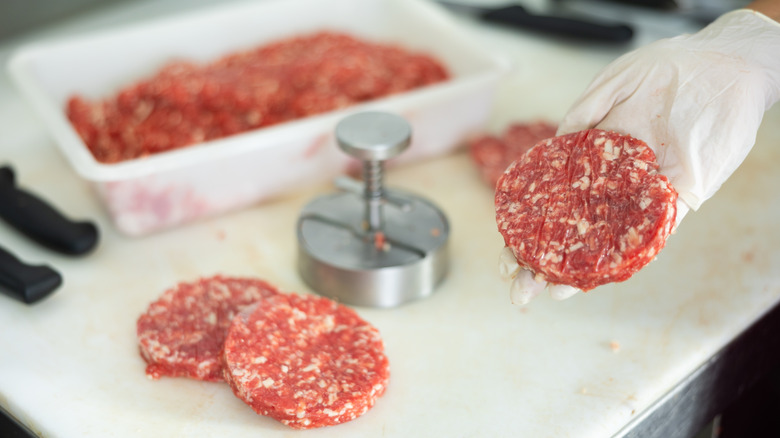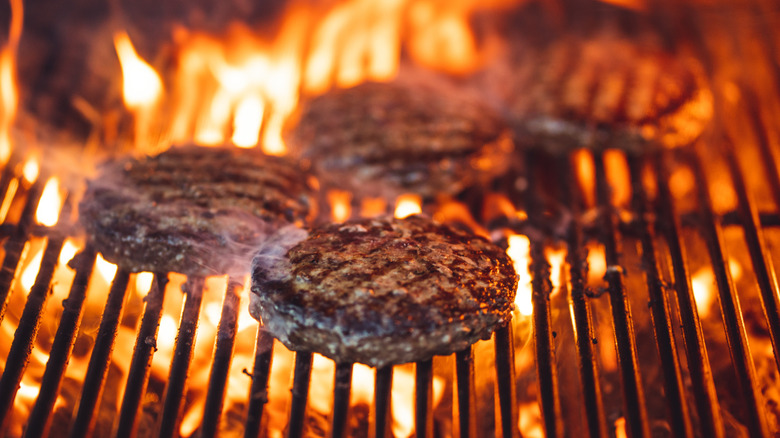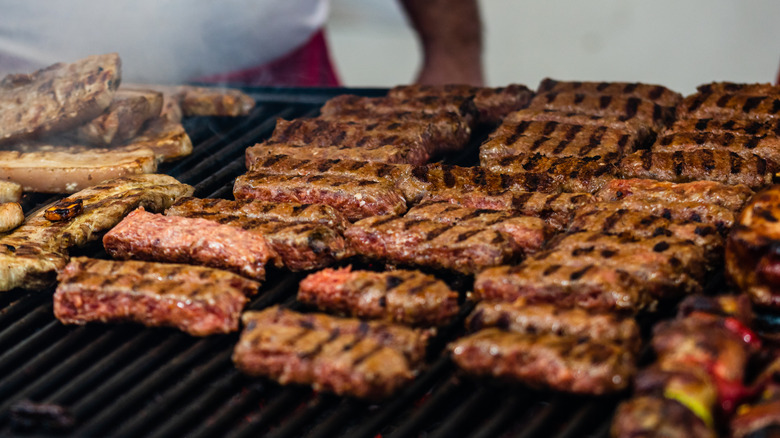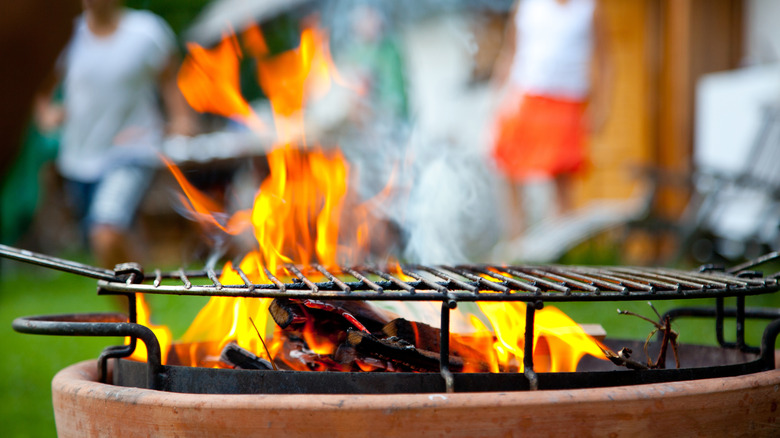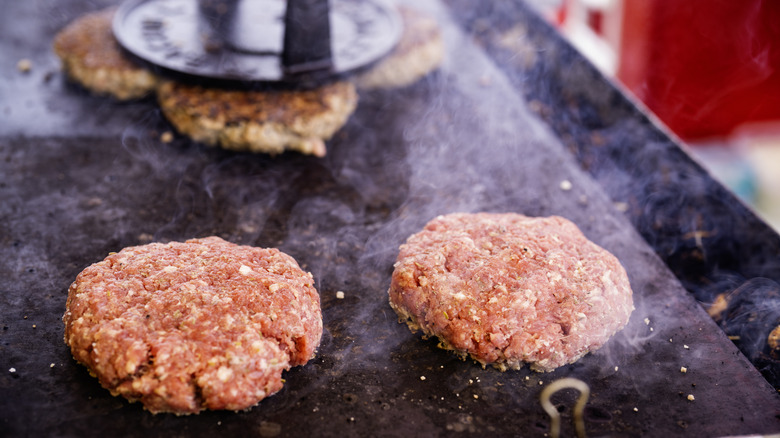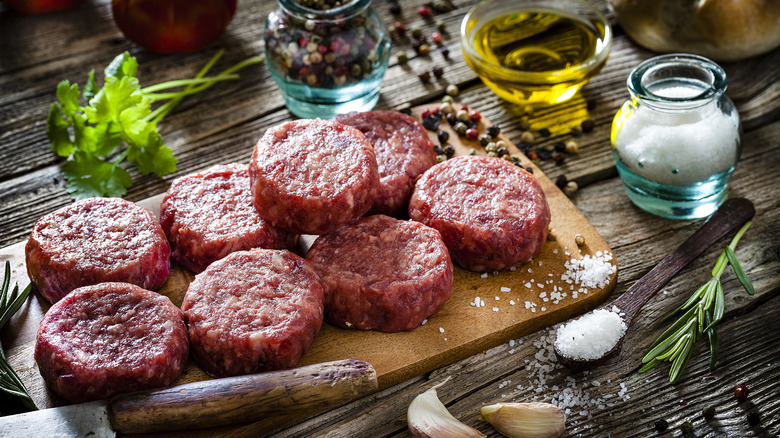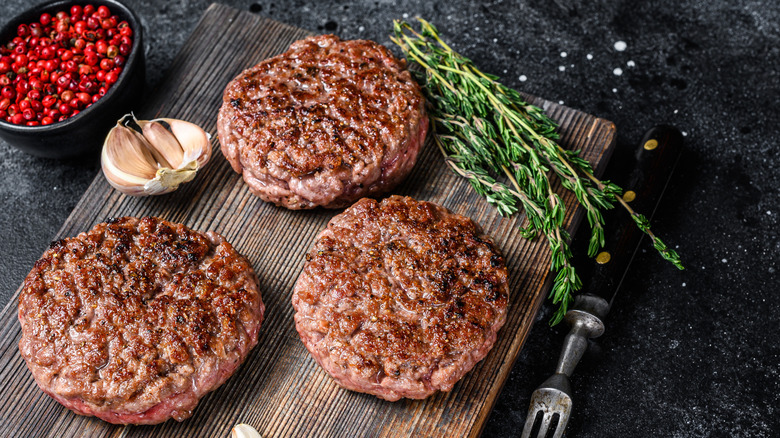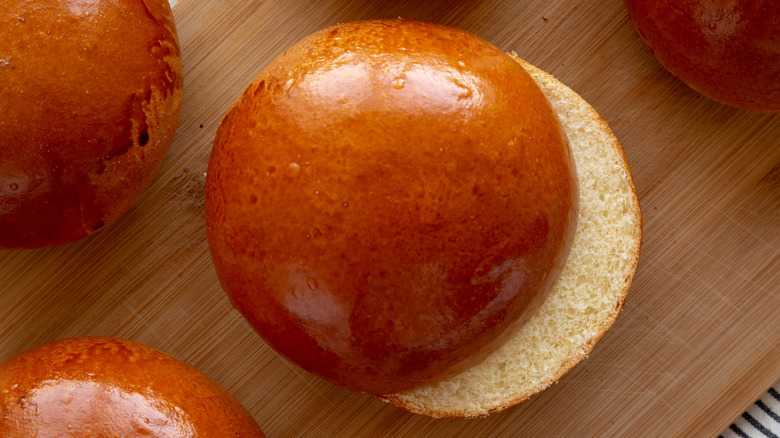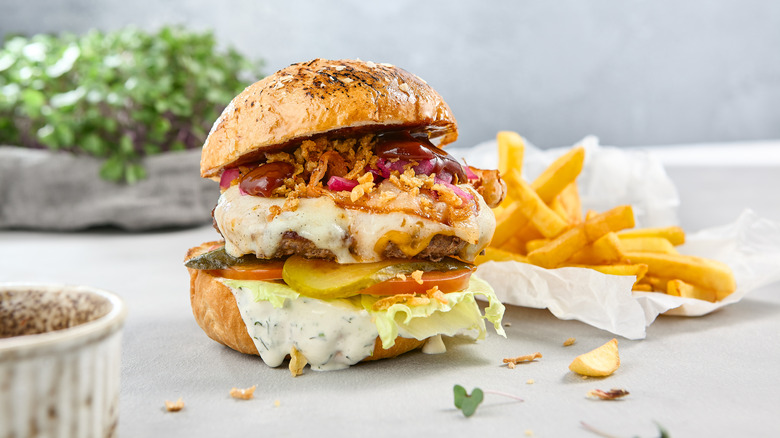12 Mistakes Experts See Home Cooks Make When It Comes To Burgers
Who doesn't love a good burger? Whether you prefer a succulent smash burger; a thick, loaded burger piled high with toppings; a burger stuffed with cheese, bacon, and other accoutrements; or just a greasy burger from your local fast-food joint, a good burger — particularly served alongside the requisite fries — is difficult to pass up. That said, making a good burger is certainly more difficult than eating one. Even if you're not getting into the fine details of mixing your own ground meat blend or stuffing patties with cheese and jalapenos, even if you purchased frozen patties from the grocery store freezer aisle, there are pitfalls aplenty at every step in the process.
Luckily, though, there are experts in the burger and beef biz who are here to help. The Takeout spoke with Jennifer Borchardt, culinary content director at Pre Brands, which specializes in grass-fed and finished beef, and Chef James Taylor of Miami's The Joyce and The Window at The Joyce, the latter of which serves up burgers worthy of the chef's Michelin-starred background, to get their top tips for home cooks. These are the top mistakes they said you need to avoid when cooking burgers at home, no matter your chosen cooking method.
1. Overworking the meat
This mistake, Jennifer Borchardt told us, is at the very top of the list. When pounding out your own patties at home, not only is it possible for you to overwork the meat while you're seasoning it and before forming it into patties, but it's also possible for you to do so while forming those patties. "Burgers require a light touch," she said. As such, go gentle on your beef or other chosen proteins, unless you want to end up with dense, tough patties.
The reason why all that over-mixing results in a bad patty texture, rather than tenderizing the patty, like you might expect? It all comes down to science. As ground meat is mixed and moved, it releases a type of protein called myosin, and the more you mix and move, the more myosin is released. The myosin almost acts like glue, keeping the meat mixture's water and fat together. If you do find that you've accidentally overworked your hamburger, try introducing some extra fat into the meat mixture, such as pork fat. If all else fails, you may need to repurpose your overworked ground beef, making something a little more forgiving, such as Italian or Asian meatballs.
2. Flipping too soon or often
Both of the experts that we spoke with mentioned improper flipping as a top mistake that home cooks often make when cooking burgers at home. While, yes, you want both sides of your burger patty to be equally done, and the burger all the way done through the middle (whatever your preferred level of doneness may be), you don't want to flip ... and flip ... and flip the burger over and over again. Both experts said that you really only need to flip your burger a single time — that's really it.
Don't get over-eager and flip your burger too soon, either. Jennifer Borchardt recommended putting your burger down on your cooking surface and leaving it as is for about four to five minutes. Then, do your single flip, and let the burger cook for three to four minutes longer on the opposite side. This will give you a nice medium-rare doneness, she said, depending on the burger patty's thickness.
Also pay attention to what you use for the flipping. Opt for a thin, flat spatula, like a fish spatula. It'll allow you to easily slide beneath the patty without breaking it and while also retaining the charred exterior.
3. Choosing the wrong ground beef
You can add the most indulgent, delicious toppings to your burger, but if the beef you use for your patty is lackluster, the burger overall isn't going to be all that great. As such, choosing the right ground beef for your burger is key.
Chef James Taylor recommends using 80/20 ground beef (so 80% lean meat, 20% fat content), for a "beefier" flavor, as well as a juicier burger. He also recommends, if you buy pre-made patties, to opt for patties that aren't overly thick. Jennifer Borchardt further noted that, if you want something leaner, to just not go any lower than 15% fat content (so an 85/15 mix). Using a leaner mix, like 95/5 ground beef, she said, will lead to dry burgers with less flavor and you might be tempted to add other fatty ingredients, like cheese, to the burger, to counteract that — which really negates the health benefits of buying the leaner beef anyway. If you are thinking about your health as you shop for burgers, she also recommended using grass-fed and finished beef, for more vitamins and minerals and more than quintuple the omega-fatty acids.
4. Neglecting to make the patties in advance
If you're in a rush, like if you're manning the grill at a party or trying to get dinner on the table fast on a weekday, keep in mind that you don't have to make your burger patties right when you plan on cooking them. Instead, consider making your burger patties in advance and storing them in the fridge or freezer for easy use whenever you're ready to cook them.
If you want to make your patties and store them in the fridge, Jennifer Borchardt said, just place them on a tray lined with parchment paper, being careful not to overlap or stack the patties, and then covering them with plastic wrap or aluminum foil. They'll be fine in the fridge like that for up to 24 hours. If you want to store the patties longer-term, you can freeze them for an hour or two, again, on your parchment paper-lined trays, and then place them in an airtight freezer bag for safe storage for up to three months. (The U.S. Department of Health & Human Services gives you a little more time, saying you can keep ground beef and burgers in the fridge for up to two days, or in the freezer for up to four months.) Then, whenever you're ready to finally cook your burgers, let them come up to room temperature for about 20 minutes.
5. Cooking on too high heat
No matter what kind of cooking method you might choose for your burgers, be sure that you're cooking your burgers at the appropriate level of heat. While Chef Taylor says you'll know your cooking surface, like a cast iron skillet or flat top griddle, is ready to go when it starts smoking, Borchardt recommends a lower temperature for cooking burgers, preferably at medium heat. This, she told us, allows the burgers to cook evenly, without burning on the exterior before they're done in the middle.
As you're cooking, do keep in mind that the U.S. Department of Agriculture recommends that you cook all ground beef, so including burgers, to a minimum internal temperature of 160 degrees Fahrenheit. However, that's going to give you a well-done burger. If you want a burger that's a little pink in the middle, say cooked to medium, you'll want to only cook your burger until it's at about 140–145 degrees Fahrenheit in the middle. That said, if you're making a non-beef burger, such as a chicken or turkey burger, you won't want to mess around with the internal temperature. Cook poultry burgers all the way, until they're well-done, to at least 165 degrees Fahrenheit, to avoid risks of foodborne illness.
6. Overcrowding your cooking surface
You may know not to pour an entire bag of frozen veggies into a small sauté pan and expect them to cook evenly. You may know not to overcrowd your baking sheet with cookies unless you want to end up with one giant mono-cookie. But you're cool to pack those burgers onto your grill, right? After all, they're cooking over an open flame. Surely they'll be fine.
Well, no. The thing is, says Jennifer Borchardt, is that if you put all of your cool or cold burgers onto the grill at once, you'll end up inadvertently lowering the grill's temperature, and this will cause uneven cooking. Additionally, when you overcrowd your grill in general, you can end up with more fat dripping down onto the open flame in certain spots, increasing your chances of a flare up. You may also find that, due to the lowered temperature, that you need a longer cooking time and it takes longer to get a char on your burgers — if you're able to get one at all.
7. Not preheating your cooking surface
While you don't want to cook your burgers over too high of heat, you don't want to put your burgers on a cold cooking surface, either. You want to preheat your cooking surface so that it's ready to start cooking as soon as you add your burgers to the grill, flat top, or cast iron.
Chef Jennifer Borchardt recommends preheating a grill for burgers for at least 10 to 15 minutes before you begin cooking. This, she said, will allow the grill to come up to a hot enough temperature to ensure your burgers sear nicely and stick together, rather than fall apart when you first try to flip them. Additionally, it'll make sure that your burgers begin cooking as soon as you place them on the grill, so you're not spending extra time waiting for them to actually begin to brown, making for burgers that aren't evenly cooked and possibly even overcooked, as you wait for that sear to show up.
8. Choosing the wrong cooking method
You might automatically head to the grill when you're ready to cook some burgers, but don't overlook your other options. In fact, Chef James Taylor says that there are far more superior ways to cook burgers at home. He said, "Most home cooks think that using an open-fire grill is the best method, but I find that it tends to cook inconsistently or dry out the product."
So what should you do instead? If you have the space, he noted, consider investing in a Blackstone griddle. The hot flat top, he explained, will help seal in all your burger's delicious juices, while also helping you avoid the overcooking and burning that can sometimes happen on the grill. If you don't have space for a Blackstone griddle, a cast iron pan is another good option.
If you do cook your burgers in a cast iron skillet, make sure to add a little lubricant in the way of a bit of oil, and to preheat your skillet, just as you would a grill, before adding your patties.
9. Adding anything besides meat and fat to your patty blend
While you can certainly just make burgers using your favorite ground beef (whatever lean-to-fat ratio you prefer), many people are tempted to craft a patty blend using an array of ingredients that they say make the burger patty juicier or more flavorful. However, chef James Taylor urges you to keep things simple, as making your own patty blend is one of the areas where you can really go wrong as a home cook. "The issue here is that there are so many factors with ground beef. How coarse is it ground? How well is it mixed? What is the ratio or beef to fat?" he said.
If you do want to create your own meat blend, he said to stick to ingredients that are exclusively either meat or fat. Go ahead and mix beef, pork and/or bacon into your patty. However, don't add extra ingredients like onions, eggs, or condiments. "Save those for the toppings," he said. "Let the meat be the meat."
10. Not resting the burgers after they're cooked
Once you're finished with cooking your burger, whether you cooked it on the grill, on a griddle, or in a cast iron skillet, it's important to actually let the burger rest. Don't just plop it on the bun, straight from the grill grates, pile on the toppings, and then chow down. After cooking, James Taylor recommends you allow your burgers to rest in a room temperature pan or on a plate for at least 30 seconds. Then, you can transfer the burgers to their buns.
This resting time is important for burgers just the same way it's important for all meats. When a protein like beef cooks, the meat fibers contract. This forces all of the moisture within the meat to one spot. When you allow a protein to cool, though, the meat fibers can relax and that moisture can redistribute throughout the entire portion of meat, so that each bite is just as juicy as the last (instead of all of your meat's juices running down your chin with the first bite, leaving you with a somewhat dry patty for the rest of the meal).
11. Choosing the wrong bun
After choosing the right type of ground beef for your burger, what would you imagine would be the second-most important ingredient in your burger-building efforts? Perhaps it would be the vessel that holds your burger, aka, the bun.
According to chef James Taylor, the bun is a big deal. He prefers using brioche buns — and if you're not familiar, brioche is a bread with French origins that offers a tight crumb, hearty texture, and density, but also a certain softness and sweetness — as they're sturdy enough to hold up a hearty burger, while also adding extra flavor. In other words, brioche is far from boring.
Then, he said, don't just serve your burgers on buns that are room-temperature. Toast the buns. When it comes to something like brioche, there's actually butter within the bread, and heating the buns up makes that more apparent. "Think about the difference between warm bread and room-temperature bread," Taylor said. "Everyone loves warm bread!"
12. Over-complicating your burger
Then, don't succumb to the urge to complicate your burger. Yes, we've all seen those burgers that are trendy, on social media, crowned with extravagant combinations of over-the-top toppings, or burgers that use unexpected items in the place of a traditional bun. You may have also seen burgers stuffed with enough ingredients in the middle of the patty that there's not even any need for other toppings. However, both of our experts caution against over-complicating your burger.
Chef Jennifer Borchardt said, "When it comes to burgers, simple is always best. I recently saw a 'donut burger' with a glazed donut as the bun — combining two good things does not always mean a good end product! I also don't advocate for many additional ingredients to the burger mix. Too many mix-ins, like breadcrumbs, eggs, or veggies, can change the texture and flavor."
Keeping your toppings simple, though, doesn't mean neglecting care. According to chef James Taylor, you can make small decisions that really elevate your burger. For example, if you're making a cheeseburger, make sure your cheese is as melted as possible, and if you're going to use lettuce, shave it down until it's razor-thin.
